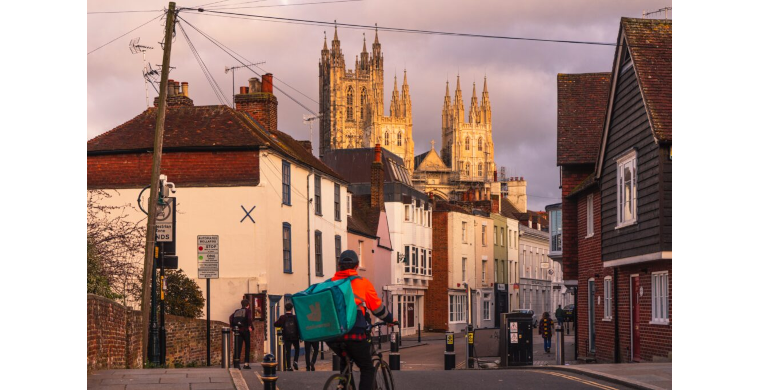St Thomas Becket's shrine has a fine and sacred story: Now they (literally) dance around his grave
By Gavin Ashenden
https://catholicherald.co.uk/
January 10, 2024
Canterbury Cathedral is set to host the latest Anglian gimmick.
Scarcely a month seems to go by in the United Kingdom without a small scandal relating to a medieval Catholic cathedral sequestrated at the Reformation and now run by the Church of England. The current cathedral custodians in different places have resorted to golf courses, helter skelters, risque film clubs and gin distilleries.
Now Canterbury Cathedral, built by the Benedictines as the seat of St Augustine, is turning itself into a night club with its forthcoming "rave in the nave". The Dean, Dr David Monteith, has been honest, although he has talked unconvincingly in terms of "getting the youth into church".
No one seriously believes that tipsy dancing kids gyrating to vulgar lyrics are likely to leave more open to an experience of the sacred and the numinous than when they came in. God can act in whatever way He chooses, of course, but He seldom overmasters the preferences we have chosen for ourselves.
This new venture seems to be mainly about money. Canterbury Cathedral was not always short of money, it must be said. It was once, under Catholic ownership, a place of substantial wealth -- and that wealth came about as an expression of gratitude for answered prayer.
Before the Reformation, the shrine of St Thomas Becket drew pilgrims in enormous numbers. He was revered throughout medieval Europe as a martyr for the faith. That might have made for a well-resourced memorial just as a symbol; but at Catholic Canterbury the shrine was far more than symbolic. It "worked" as a place of miraculous healing.
It was the miracles that really put Canterbury on the map spiritually, rather than politically or ecclesiastically. Within just ten years of his death in 1170, more than 700 healing miracles had been recorded at Becket's tomb. Pilgrims knelt and said their prayers in the presence of relics which included his body, a fragment of the sword used to kill him, and the piece of his skull that it had sliced off, which was preserved and venerated separately.
Pilgrims came in part because Becket was famous and his martyrdom was inspirational; they came also because pilgrimages were virtuous cultural expressions of love of God. But they came in particular to Canterbury Cathedral because of the reputation for answered prayers for healing. And those whose bodies, minds and souls were healed responded in gratitude, with gifts of their wealth. The shrine become increasingly adorned with marble, gold and jewels.
It's tempting under the influence of the secular mind, which all of us have had shaped by our culture, to be reasonably suspicious about claims for the miraculous. It might surprise some people to know that the medieval mind was just as concerned for testing the truth and guarding the integrity of reality as the modern mind. Who, then, took responsibility for recording what happened?
Expecting a popular reaction to Becket's death, and suspecting that the king might attempt to remove the body, the monks at the cathedral guarded Becket's first tomb in the cathedral crypt. There was always someone there, and as the people came to give thanks for the miracles they experienced, they reported it to the monk on duty, who wrote it down.
There were two prominent monks at the outset who oversaw the process; Benedict of Peterborough and William of Canterbury. Each took a different approach to the task.
Benedict stated that he questioned the pilgrims, tried to filter out fabrication, and record the miracles chronologically and accurately. William took over in 1172 when the shrine was becoming more fashionable, and the wealthy and powerful were visiting. He grouped miracles into types: healing, driving out demons and finding lost items.
William was more impressed by the claims of the competent (the wealthier and more educated). Benedict gave greater weight to the cases of poor women, widows and the sick, who came from the locality of Canterbury. Both cited miracles which were imitations of those of Christ and his Apostles: the healing of leprosy (defined as any skin disease), the driving out of demons and the restoration of sight.
Over the course of the ten years covered by Benedict and William, 703 miracles were recorded. During 1171 there were estimated to have been 100,000 visitors to the shrine, so the number of accepted miracles is therefore relatively modest. Becket was canonised in 1173, less than three years after his death and one of the fastest canonisations of the 12th century.
Gifts from pilgrims included jewels presented in personal gratitude by King Louis XI of France. In 1539, however, Henry VIII destroyed the shrine and the relics. Scattering anything left of Becket himself, the state stole the money and jewels.
It seems as though it has yet to occur to the dean and Chapter of Canterbury -- the present curators of Becket's cathedral -- that there might be any connection between spiritual and material wealth. But as a piece of theological reflection, it ought to be considered.
***
Update: Canterbury Cathedral says that the event "will take place solely in the Nave, nowhere near either the Martyrdom, the Crypt (the site of Becket's original tomb), or the Cathedral's Trinity Chapel (where Becket's shrine stood). No one will 'literally dance on his grave'". [The article's original title could have been interpreted as suggesting this.] The Dean and Chapter also wish to clarify that "rave in the nave" is incorrect, "as the event is a retro disco". Our thanks to their Communications Manager, Nathan Crouch, for getting in touch.














